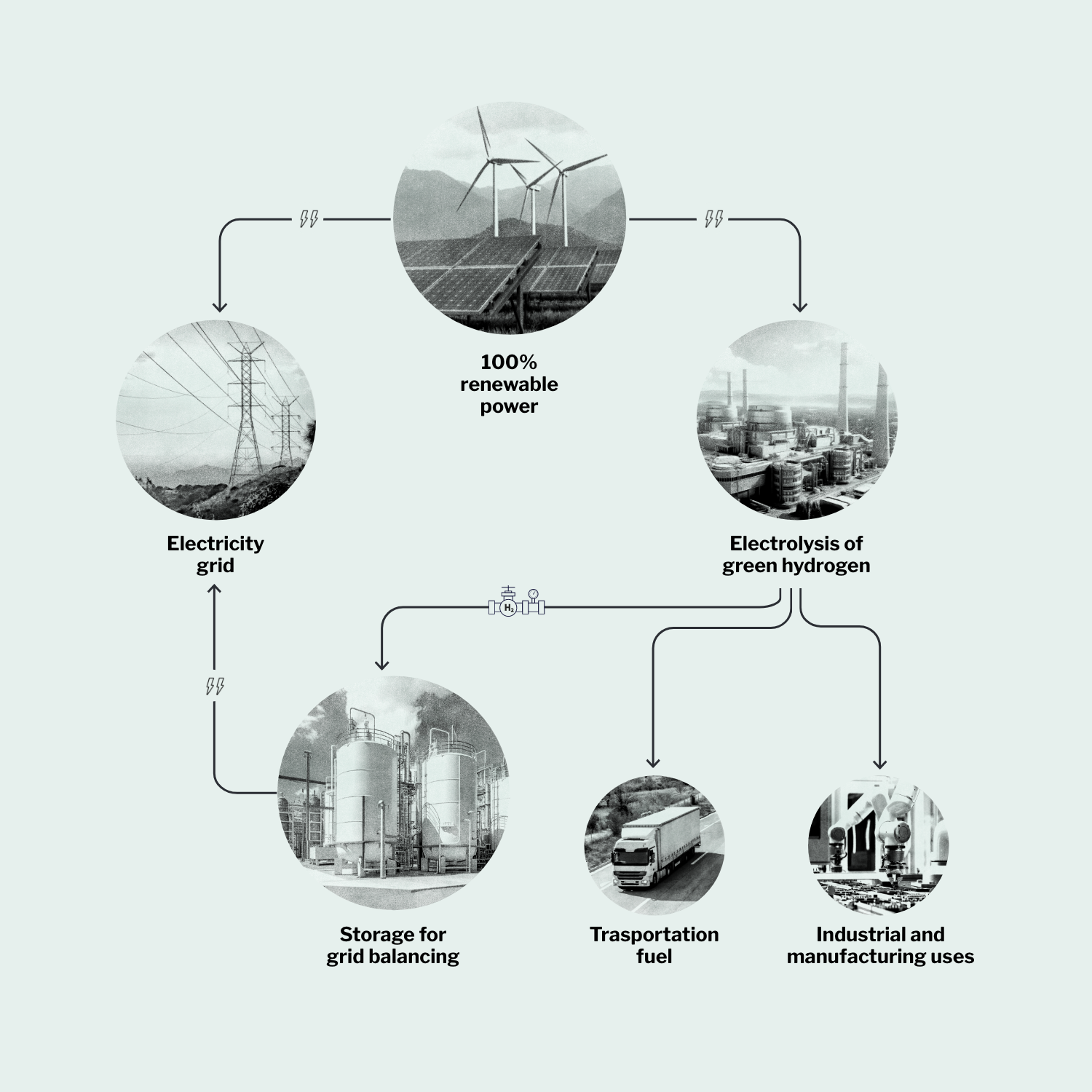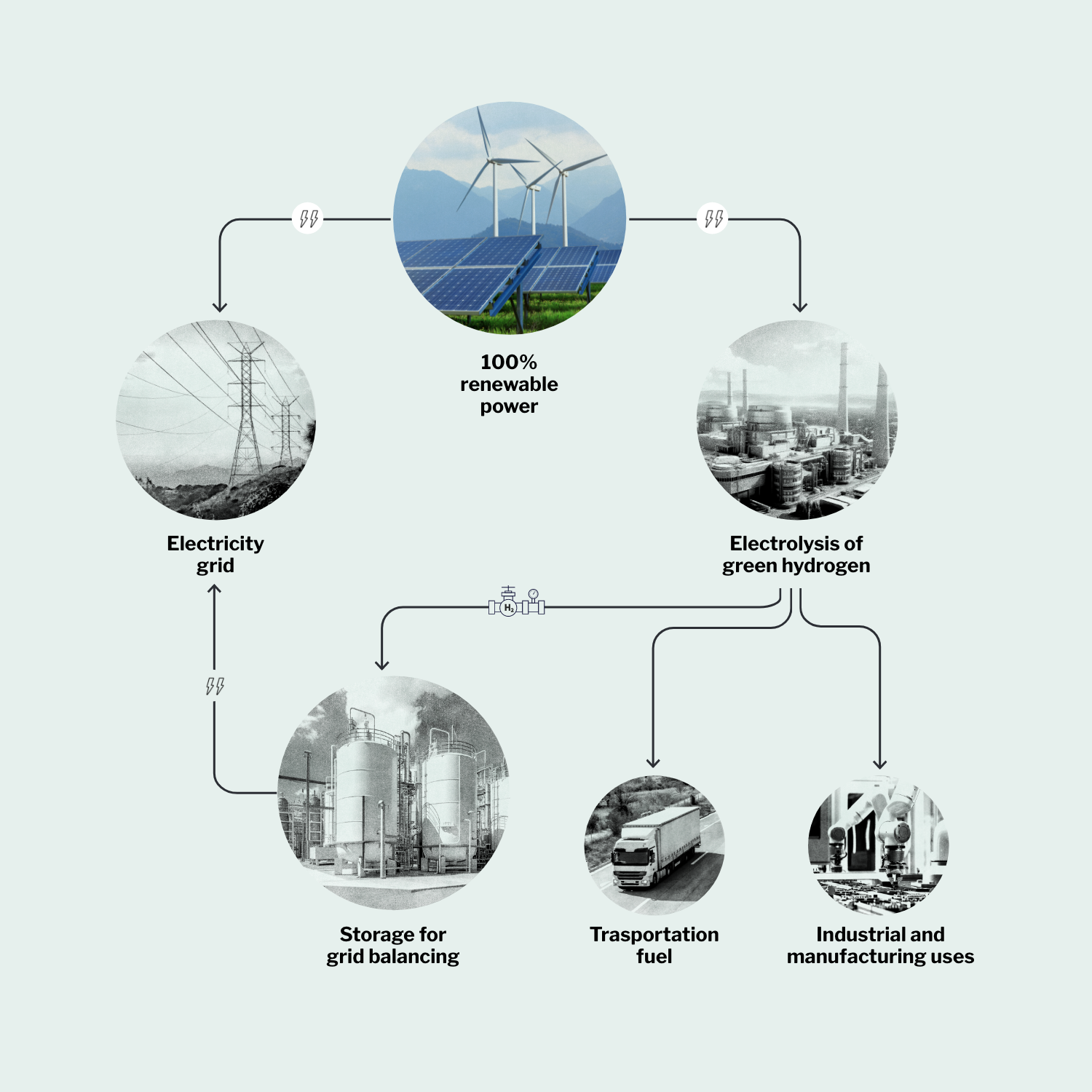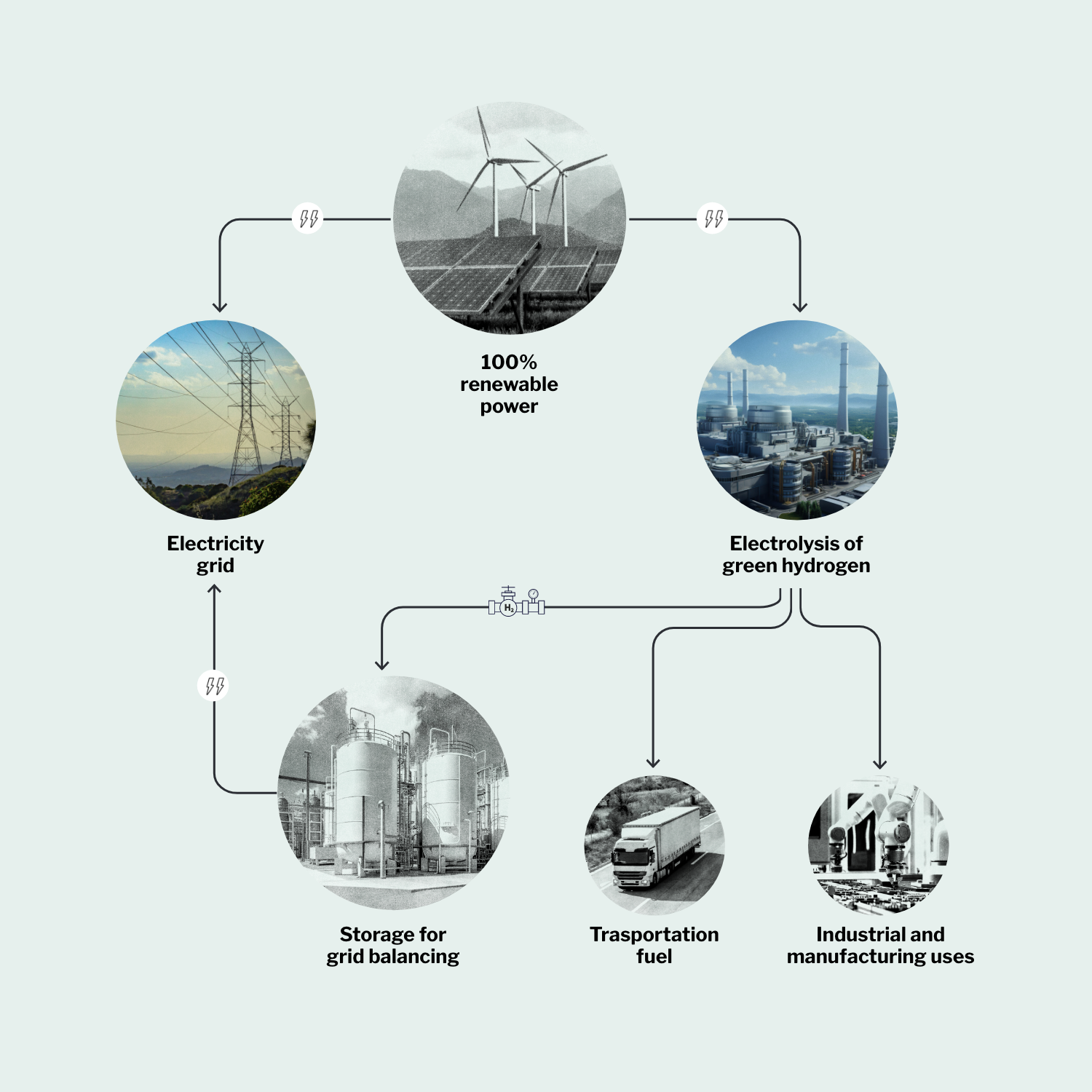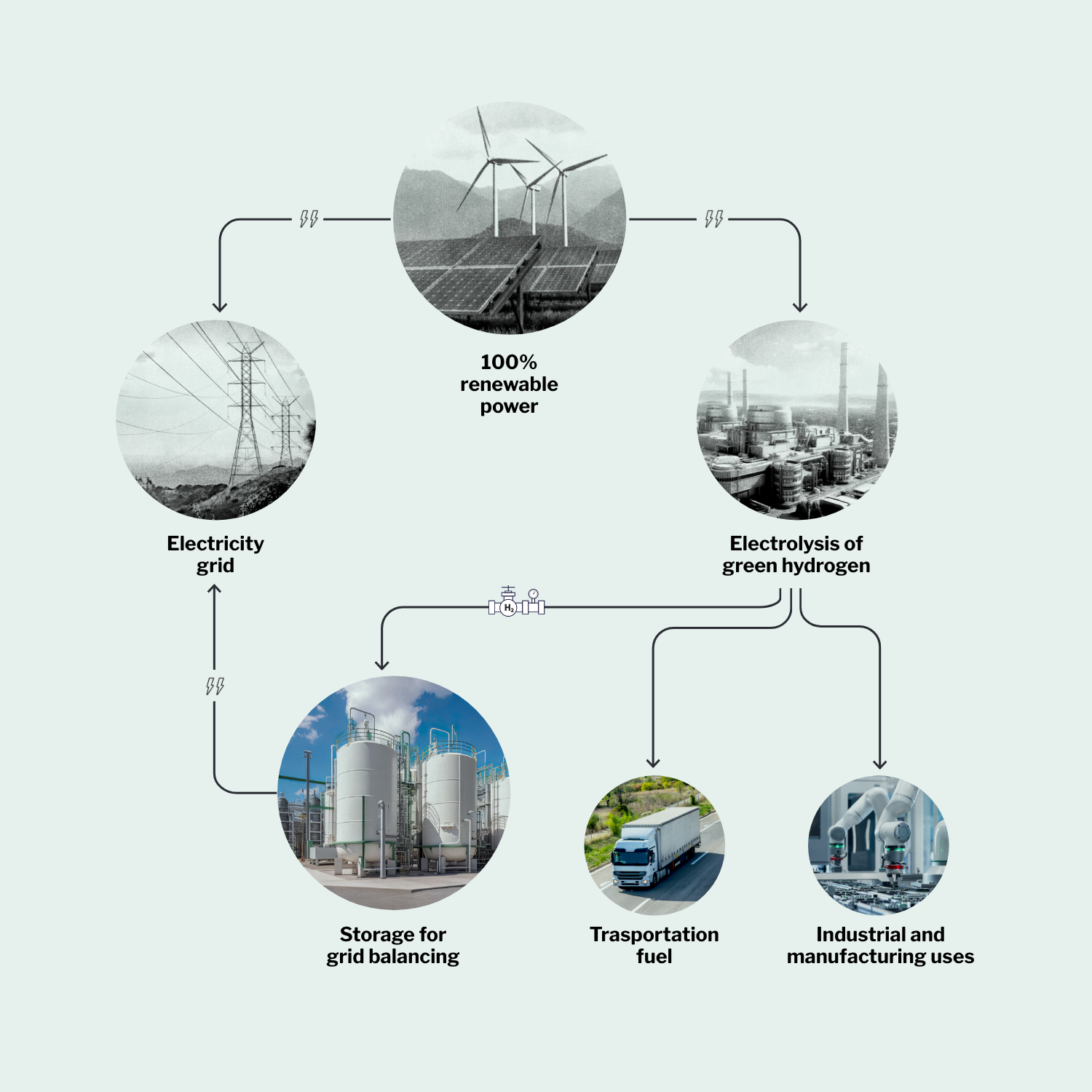Fostering Energy and Climate Security as Part of a Just Transition
Complementary pathways to reduce carbon emissions, scale up clean energy technologies, and drive sustainable growth
An issue brief by FP Analytics, with support from the COP28 Presidency
October 2023
At COP28, to be hosted this year in Dubai, the international community will participate in the first-ever global stocktake to assess whether the goals of the 2015 Paris Agreement are being met and to reaffirm stakeholders’ commitments toward sustained decarbonization. Accelerating, not just ensuring, progress at this time is imperative to keep global warming below the pre-industrial 1.5 degrees Celsius level required to avert climate catastrophe. For governments, industries, and multilateral leaders, the challenge is to transform the planet’s energy landscape while meeting the energy needs of the global population of eight billion and counting.
This monumental task requires a two-pronged approach. The international community needs to ensure that people everywhere have access to clean, affordable energy while enabling the responsible production and consumption of renewable and non-renewable resources. To achieve these goals, leaders in Dubai need to mobilize collective action and target investments across three priority areas:
- End energy scarcity and expand clean, affordable energy access by vastly scaling up renewable power generation and including local stakeholders in the process.
- Decelerate global warming by greening our energy supply, removing carbon from the atmosphere, and reducing methane emissions.
- Slash greenhouse gas (GHG) emissions and environmental pollution by commercializing and deploying low- and zero-carbon fuels for the hardest-to-abate sectors.
With these objectives in mind, COP28 can serve as a critical juncture, one in which parties across all sectors advance environmental stewardship alongside economic growth and prosperity. This issue brief delves into the challenges and opportunities that lie ahead.
Strengthening energy security by expanding access to reliable, clean, and affordable power
Addressing both climate and energy security challenges simultaneously is no easy task. Among many actions needed, three major changes must take place: decarbonize the environment quickly and efficiently; meet increasing global energy demand; and sustainably foster inclusive economic growth.
As an example, achieving net zero by 2050 depends heavily on scaling up renewables, which the International Energy Agency (IEA) forecasts will need to account for 90 percent of global electricity generation, including 70 percent from solar and wind power alone. This will require a mass mobilization of resources. To keep the 1.5 degrees Celsius target within reach, renewables capacity must triple by 2030.
One initiative demonstrating expansion of renewable energy access is the recently completed Al Dhafra PV2 Solar project. One of the world’s largest solar-power installations, it has three million solar panels and 2.1 gigawatts (GW) of power capacity, enough to supply electricity to 160,000 homes. It will reportedly sell electricity to the Emirates Water and Electricity Company at an industry low of USD 1.35 cents per kilowatt hour (kWH), thus driving down energy costs. But projects like this are rare, especially in low- and lower-middle-income countries (LMICS) where there is a heavy reliance on fossil fuels and limited connectivity.
Global Access to Electricity
One in ten people around the world today lacks reliable access to electricity, undermining their productivity and health outcomes, and hindering economic growth.
DATA SOURCE: the world bank
Global Access to Clean Cooking Fuel
More than a quarter of all people globally lack access to clean cooking fuels and therefore resort to environmentally harmful, unhealthy, and inefficient alternatives.
DATA SOURCE: the world bank
Looking at the bigger picture, three-quarters of a billion people, almost one-tenth of the world’s population, lack reliable access to electricity. Global electricity demand is also expected to increase anywhere from 33 to 75 percent by 2050, with the bulk of that demand driven by economic and population growth in countries outside of the Organisation for Economic Cooperation and Development (OECD). But the news need not be dire. The need for connective infrastructure across many LMICs offers an opportunity: to leapfrog to cleaner, more sustainable generation to power local communities.
Projects producing cleaner power while closing the energy access gap are already proliferating. For example, the UN’s Africa Mini-Grids Program (AMP) is developing low-emissions pathways to reach areas with limited electrification. AMP’s goal is to develop solar mini- or micro-grids—small, modular networks of solar panels, energy storage, distribution systems, and backup generation—to meet the needs of local communities. Across 21 countries, the program is enabling the construction of 110,000 mini-grids that will eventually electrify 200,000 schools and clinics and an estimated 900,000 businesses.
These and other clean energy technologies are also potential job-creators. They provide opportunities to train or reskill local populations in the production, management, and maintenance of such systems, which can boost incomes and economic growth.
Closing the clean energy access gap by 2030 will, however, require mobilization of an estimated $40 billion annually. Climate finance, which will be highlighted in Part 2 of this series, is vital to accelerating action and realizing impact.
In the meantime, there is another challenge to be faced: greening our existing systems.
Slashing emissions being generated today
Sequestering carbon
Stemming global warming and tackling climate change is a formidable challenge. It requires capturing carbon from the energy and industrial sectors, removing it from the atmosphere, and reducing methane emissions. Major strides are needed across multiple industries.
Among the pathways to tackling emissions from heavy emitting sectors such as cement, steel, and chemicals, carbon capture, utilization, and storage (CCUS) technology has the potential to capture 90 percent of carbon-dioxide emissions from industrial facilities, if such technology is made viable and affordable. The captured carbon can be repurposed in industrial processes.
Governments and industry have contributed to the development and deployment of these projects. As of 2022, CCUS projects accounted for 45.9 million tons per year of carbon capture worldwide. That same year, Petrobras reported 10.6 Mt of operational CCUS systems, the ExxonMobil Shute Creek gas facility a carbon capture capacity of 7.0 Mt. By 2030, CCUS capacity is expected to grow more than six-fold, to 320.9 million tons. But achieving net zero by 2050 demands reaching 4.2 gigatons.
Another, potentially transformational technology is direct air capture (DAC), which involves removing carbon directly from the atmosphere. DAC initiatives are underway worldwide, including in Kenya, where a project supported, in part, by the U.S. Department of Energy seeks to remove up to 10,000 tons of carbon-dioxide per year using electricity and steam generated by geothermal power. The project’s success, however, relies on realizing Kenya’s 10 GW of geothermal energy potential, of which less than one-tenth is being harnessed today.
The fact is, many technologies are only in the pilot or demonstration stages, and backed by limited funding. Global investment in CCUS was $6.3 billion in 2022, a fraction of the estimated $3 trillion needed to achieve net zero by 2050. Operationalized at scale, CCUS technology could account for 15 percent of carbon emissions reductions. But it needs to be paired with other emerging technologies to rein in GHG emissions and make global climate goals achievable.
Reducing methane
Another primary target in tackling climate change is methane. Produced largely by agriculture, fossil fuel, and waste sources, it has more than 25 times the warming potential of carbon dioxide over a 100-year period. Oil and gas industry emissions are the easiest to abate, but human activity exacerbates the problem. Driven by anthropogenic climate change, melting permafrost and shifting rain patterns, for example, significantly increase emissions. To step up progress, methane needs to be managed more effectively in developed and developing contexts alike.
Fortunately, projects worldwide show great promise. The Puente Hills Landfill Gas-to-Energy Facility in Los Angeles collects enough methane to power 70,000 homes. A pilot program in Balikpapan, Indonesia, repurposes methane emitted from a local landfill as cooking fuel. Other strategies, such as rotational grazing—routinely cycling livestock through different grazing areas—reduces methane emissions while raising productivity.
To cut methane emissions at scale, incentive structures and policies tailored to different sectors need to be developed through public-private partnerships. Policymakers, collaborating with scientists and industry leaders, also need to establish comprehensive methane-monitoring mechanisms to ensure accurate emissions tracking. The Global Methane Pledge—an alliance of 100-plus countries seeking to cut methane emissions by 30 percent by 2030—could help incentivize impactful policies, but only if members enact the requisite policies.
Another key strategy to addressing the climate and energy security challenge is making energy-intensive industries cleaner and more efficient.
Commercializing green, high-density fuels for the hardest-to-abate sectors
Ensuring worldwide energy security requires, in part, doubling down on innovation and the commercialization of technologies that can drive deep decarbonization. Partnering with the private sector, governments need to strengthen policies and investments that accelerate the commercialization of low- or zero-carbon sources of high-density fuels.
Cleaner hydrogen, a key component in many heavy-duty industrial processes, could be instrumental in moving the needle. Today, almost all hydrogen is produced without carbon abatement—and two-thirds of that production is confined to just four countries: China, Australia, Chile, and the United States. Commercializing promising blue and green hydrogen pathways, by replacing fossil feedstocks with low- or zero-carbon sources, could help decarbonize hard-to-abate industries.
Hydrogen also has the potential to drastically reduce emissions from the transportation sector, particularly long-haul trucking and maritime shipping. In the IEA’s net zero by 2050 scenario, hydrogen and hydrogen-based fuels ultimately account for more than 25 percent of the transport sector’s energy demand, with the potential to create up to two million jobs per year.
While potentially transformational, deployment of hydrogen does have its challenges. The upfront costs to build out hydrogen infrastructure and repurpose gas infrastructure are high, for example, and the CCUS technology needed to develop blue hydrogen and the renewables capacity for green hydrogen vary from country to country. However, innovative, cross-sector collaborations are advancing projects that could serve as templates for adaptation elsewhere.
Hydrogen hubs—areas where production, storage, connective infrastructure, and potential end uses are located—serve as models of the benefits of hydrogen-based ecosystems. For example, the HEAVENN project in the Netherlands, which involves 31 public and private entities from six countries, is developing a green hydrogen valley harnessing the immense wind power capacity on the North Sea. This hydrogen could be used in sectors such as manufacturing, steelmaking, transportation, and agriculture. Its many applications are also expected to generate substantial employment opportunities.

Green Hydrogen Valleys as Decarbonization Ecosystems
Green hydrogen valleys, areas where hydrogen production is co-located with a range of applications across sectors, demonstrate the interlinked and multifaceted uses of hydrogen to enable decarbonization.

To maximize the decarbonization benefits of hydrogen, it needs to be produced using renewable energy, such as from wind, solar, or geothermal sources. Currently, green hydrogen projects are generally in areas with established renewables capacity.

Renewable energy is used to make green hydrogen through a process called “electrolysis” during which electric current is used to split water molecules into oxygen and hydrogen.

The resulting hydrogen can then be employed for a range of uses, from balancing the power grid during periods of intermittent renewables supply, to generating hydrogen fuel cells for transportation, to decarbonizing certain manufacturing, industrial, and chemical processes.
Advanced biofuels are also predicted to play a major role in the decarbonization of emission-intensive sectors, notably aviation, which accounts for 2 percent of global emissions. Moving beyond conventional feedstocks, food-based feedstocks, such as sugarcane, soy, and palm oil, which have been shown to have impacts on commodity prices and food security, advanced biofuel producers are harnessing agricultural and forestry residues, non-food crops, waste residues, and even algal biomass as inputs. The International Energy Agency projects that reaching net zero by 2050 will require that advanced biofuels produced from waste, residue, and non-food feedstocks grow from 9 percent of all biofuels in 2021 to more than 40 percent by 2030.
The world’s largest biofuels project, Biorefineria Ciudad Dorada (“Golden City Biorefinery”), is in development in Panama, seeking to repurpose existing bunker fuel oil facilities to sustainably produce 2.6 billion gallons of aviation fuel annually from plant oils, waste fats, and greases. In 2021, the European Commission also adopted the RefuelEU Aviation initiative to incentivize the use of sustainable aviation fuels, with a goal of 70 percent utilization by 2050 at EU airports. Achieving this goal will be crucial to realizing the International Air Transport Association’s net zero by 2050 target.
As of 2022, however, biofuel accounted for less than 0.1 percent of all aviation fuel consumption. Scaling up the production and deployment of biofuels will require government and industry collaboration to overcome concerns relating to scalability, land use, and economic viability.
Cumulative Emissions Reductions in Net Zero by 2050 Scenario
The IEA identifies emissions reductions from seven categories—renewables, electrification, CCUS, technology performance, hydrogen, behavior and avoided demand, and other fuel shifts—as the key components to achieving net-zero emissions.
DATA SOURCE: IEA
Looking ahead to COP28
While progress is being made on many fronts, the international community is far from reaching its collective goals. To date, just $19 trillion of the estimated $37 trillion in global financing needed to be on track for clean energy transition by 2030 has been committed. Perhaps more telling is that, while developing and emerging economies are home to two-thirds of the global population, they account for just one-fifth of all investments in clean energy.
Resource expenditure needs to be reconceptualized as a long-term investment encompassing climate, socio-economic, and security benefits. It also needs to ensure that local communities not only have a seat at the table but a stake in the outcomes, including training, reskilling, and upskilling efforts to integrate workers into the transition.
With regard to the COP28 global stocktake, the United Nations Framework Convention on Climate Change (UNFCCC) has emphasized the need for systems transformation “across all sectors and contexts,” including “both supply- and demand-side measures.” Accomplishing a broad range of ambitious goals at COP28 will hinge on an ecosystem of actors—governments, industries, multilateral institutions, international development organizations, and civil society groups. All stakeholders are integral to generating momentum and ensuring measurable progress that addresses climate change while expanding energy access and supporting sustainable growth.
Recognizing that enabling progress will require resource mobilization, this series’ next issue brief will focus on opportunities for the public, private, and multilateral sectors to increase financing for climate resilience, including in the most at-risk countries. This is especially important, because just 16 percent of the $3.8 trillion public- and private-sector funding needed annually to meet the 2025 climate goals has been deployed, and only 30 percent of that funding targets emerging and developing markets.
Plans for targeted spending need to be both intentional and inclusive. Only then will the commercialization and deployment of key technologies have the potential to lower our carbon footprint, train and upskill workers, safeguard vulnerable communities from environmental shocks, and reorient systems toward greater sustainability. Now is the time, and action must be taken that will drive impact at scale.
Read the second issue brief
Read the third issue brief

This issue brief was produced by FP Analytics, the independent research division of The FP Group, with support from the COP28 Presidency. FP Analytics retained control of the research direction and findings of this brief. Foreign Policy’s editorial team was not involved in the creation of this content.

